Water and Wastewater Engineering
Подождите немного. Документ загружается.


23-38 WATER AND WASTEWATER ENGINEERING
NO
x
nitrate produced in aeration zone as a concentration relative to influent flow, mg
NO
3
-N/L
N
e
effluent NO
3
-N concentration, mg/L
R RAS recycle ratio RAS flow rate/influent flow rate
Temperature corrections and internal recycle ratios (IR) corrections greater than one are
made using the following equations:
SDNR SDNR
T
T
20
20
()
(23-55)
where temperature coefficient 1.026
T temperature, C
For IR SDNR SDNR ln F/M
adj
2 0 0166 0 0078
1
..()
(23-56)
For IR SDNR SDNR ln F/M
adj
3 4 0 029 0 012
1
-..()
(23-57)
where SDNR
1
SDNR value at an internal recycle ratio = 1.
If the F/M is less than or equal to 1.0, no correction is required.
In contrast to the preanoxic processes, the process and organic substrate used are well defined
in postanoxic processes. For thes e reasons, the SDNR design approach is not appropriate for
postanoxic proce
sses (Metcalf & Eddy, 2003).
Sludge Volume Index
The sludge volume index (SVI) is the volume of one gram of sludge after 30 minutes of settling.
The SVI is determined by placing a mixed liquor sample in a one- to two-liter cylinder and mea-
suring the volume of sludge after 30 minutes. A corresponding sample of the sludge i
s taken to
measure the MLSS concentration. The SVI is calculated as:
SVI
settled volumeofsludge mL/L mg
()(,10
3
//g
MLSS mg/L
)
,
mL
g
(23-58)
An SVI of 100 mL/g or less is considered a good settling sludge. An SVI above 150 is typi-
cally associated with filamentous growth (Parker et al., 2001).
There are several alternative methods for conducting the test. The preferred technique is to
use a vessel that is larger than a one- or two-liter cylinder. The vessel is equipped
with a slow-
speed stirring device.
The test is empirical. Because of this, the results may lead to significant errors in interpreta-
tion. For example, if a sludge with an MLSS of 10,000 mg/L did not settle at all after 30 minutes,
the SVI would be 100!
A rearrangement of Equation 23-58 has been used as a design tool to pred
ict the MLSS con-
centration in the return sludge. The MLSS is estimated by assuming the desired SVI:
X
()( )1 000 1 000,,mg/g mL/L
SVI
(23-59)
where X = MLSS, mg/L.
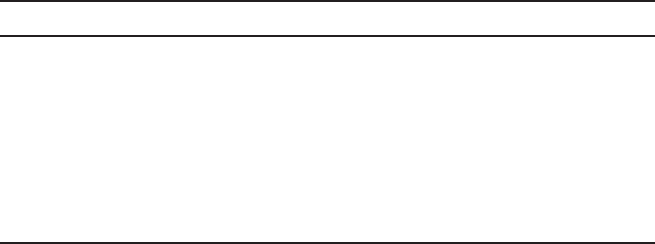
SECONDARY TREATMENT BY SUSPENDED GROWTH BIOLOGICAL PROCESSES 23-39
Because it is impossible to relate SVI to MLSS by any fundamental principles, its use as a
basis of design is problematic at best and may, in the worst case, lead to significant design errors.
It assumes that the underflow concentration from the secondary settling tank is fixed by the
concentration of the sludge and is totally independent of the design of the final settling tank or the
manner in which it is operated (Dick, 1976).
The use of an assumed SVI for design is not recommended. It rationalizes a bold assump-
tion. It is more realistic to make an assumption about the MLSS concentration within typical
design ranges, provi
de a rigorous secondary clarifier design, and provide sufficient flexibility in
the operation of the system to achieve good settling.
Nonetheless, the SVI may be the best available method for operators to evaluate perfor-
mance of their clarifiers because its conservative characteristics compensate for unknowns in the
behavior of the sed
imentation basin (Dick, 1976).
Volumetric Loading
The volumetric organic load ing is defined as the amount of BOD applied to the aeration basin
per day. Organic loadings are expressed as kg BOD
5
/ m
3
· d. This parameter served as an early
method to chec k for adequate treatment of domestic wastewater. It still appears in GLUMRB
documents and serves as a very conservative check on aeration tank design for BOD oxidation.
It is not useful in predicting effluent quality for biological nitrogen and phosphorus
removal. It is
not a design parameter; it is not an operating variable.
23-7 SUSPENDED GROWTH DESIGN PRACTICE
T ypical design parameters for commonly used processes are summarized in Tables 23-7 , 23-8 ,
and 23-9 .
Process SRT, d MLSS, mg/L HRT, h RAS, %
Complete mix 3–15 1,500–4,000 3–5
25–100
a
Contact stabilization 5–10
1,000–3,000
b
0.5–1
b
50–150
6,000–10,000
c
2–4
c
Conventional plug-flow 3–15 1,000–3,000 4–8
25–75
a
Extended aeration 20–40 2,000–5,000 20–30 50–150
Oxidation ditch15–30 3,000–5,000 15–3075–150
Sequencing batch reactor 10–30 2,000–5,000 15–40 N/A
Step feed 3–15 1,500–4,000 3–5 25–75
TABLE 23-7
Typical design parameters for carbonaceous BOD oxidation and nitrification
SRT solids retention time; MLSS mixed liquor suspended solids; HRT hydraulic residence
time; RAS return activated sludge, % of average design flow rate.
a
For nitrification rates may be increased 25–50%.
b
MLSS and HRT in contact basin.
c
MLSS and HRT in stabilization basin.
N/A not applicable.
A dapted from Metcalf & Eddy, 2003.
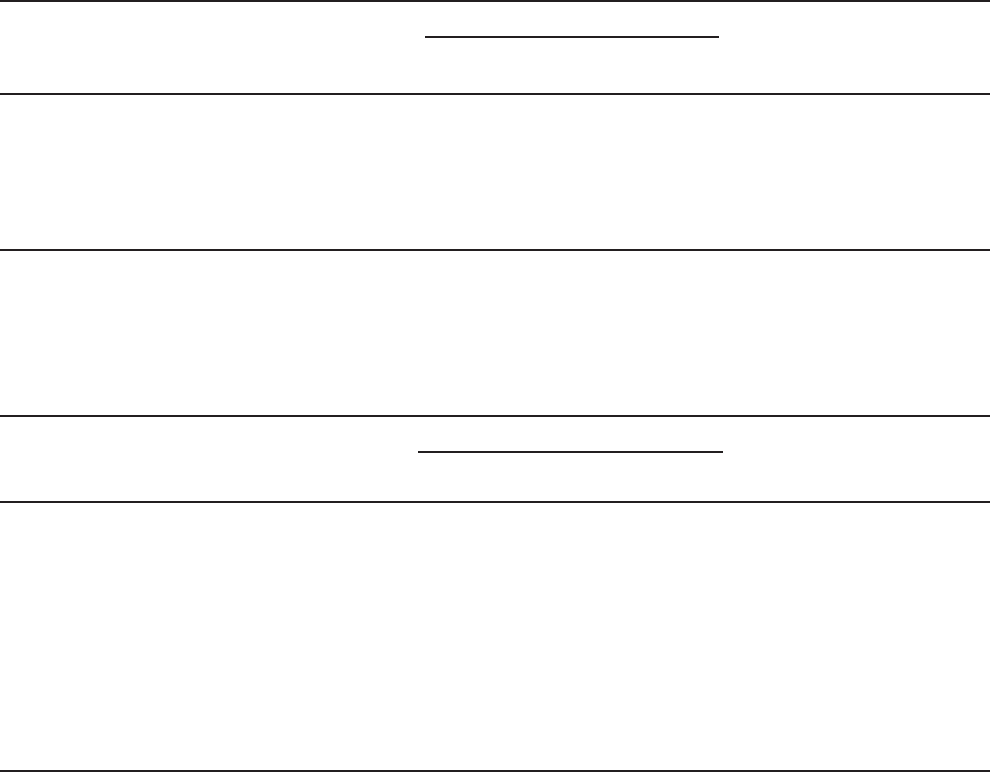
23-40 WATER AND WASTEWATER ENGINEERING
TABLE 23-8
Typical design parameters for denitrification
HRT, h
Process SRT, d MLSS, mg/L Total Anoxic Aerobic RAS, %
Internal
recycle, %
Bardenpho (4-stage) 10–20 3,000–4,000 8–20 1st stage 1–3 2nd stage 4–12 50–100 200–400
3rd stage 2–4 4th stage 0.5–1
MLE 7–20 3,000–4,000 5–15 1–3 4–12 50–100 100–200
Oxidation ditch 20–30 2,000–4,000 18–30 Variable Variable 50–100 N/A
Sequencing batch
reactor
10–30 3,000–5,000 20–30 Variable Variable N/A N/A
SRT solids retention time; MLSS mixed liquor suspended solids; HRT hydraulic residence time;
RAS return activated sludge, % of average design flow rate; internal recycle, % of average design flow rate.
N/A not applicable.
A dapted from Metcalf & Eddy, 2003.
HRT, h
Process
Aerobic
zone SRT, d MLSS, mg/L Anaerobic Anoxic Aerobic RAS, %
Internal
recycle, %
A/O 2–5 3,000–4,000 0.5–1.5 N/A 1–3 25–100 N/A
A
2
/O 5–25 3,000–4,000 0.5–1.5 0.5–1 4–8 25–100 100–400
Bardenpho
(5-stage)
10–20 3,000–4,000 0.5–1.5 1st stage
1–3
1st stage
4–12
50–100 200–400
2nd stage
2–4
2nd stage
0.5–1
Sequencing batch
reactor
20–40 3,000–4,000 1.5–3 1–3 2–4 N/A N/A
UCT 10–25 3,000–4,000 1–2 2–4 4–12 80–100 200–400
Virginia Initiative
Plant (VIP)
5–10 2,000–4,000 1–2 1–2 4–6 80–100 100–200
TABLE 23-9
Typical design parameters for phosphorus removal
SRT solids retention time; MLSS mixed liquor suspended solids; HRT hydraulic residence time;
RAS return activated sludge, % of average design flow rate.
Notes: With the exception of A/O, these processes also remove nitrogen in the anoxic stage. A/O ™ , A
2
/O
™ , Bardenpho
™
, and VIP ™ processes are patented.
Adapted from Metcalf, & Eddy, 2003.
From the large number of alternative processes that are available, the following have been
selected for more detailed discussion:
• A s an exam ple of prescriptive standard design for a small facility, a facultative oxidation
pond;
• As an example of carbonaceous BOD oxidation and nitrification, an oxidation ditch;
SECONDARY TREATMENT BY SUSPENDED GROWTH BIOLOGICAL PROCESSES 23-41
• As an example of carbonaceous BOD oxidation, nitrification, and denitrification, a
sequencing batch reactor;
• A s an example of carbonaceous BOD oxidation, nitrification, denitrification, and biological
phosphorus removal, the A
2
/O
™
process.
With the exception of the oxidation pond, the design methodology used in the examples is based
on using mean cell residence time (
c
) or its equivalent, solids retention time (SRT), as the master
variable for the designs.
Facultative Oxidation Ponds
E mpirical methods have been developed for designing facultative ponds (see, for example,
Gloyna, 1972, and Marais and Shaw, 1961). Unfortunately the predicted effluent quality often
differs substantially from the actual effluent quality. As a consequence, in an effort to compen-
sate for the many unknown de
sign and operating variables that result in unsatisfactory operation,
state standards are prescriptive and quite conservative. This philosophy is presented in the
following discussion.
Redundancy. Unlike most other water and wastewater treatment systems, there is no general
rule requiring redundant ponds. Typically there is a sy
stem of ponds. GLUMRB (2004) recom-
mends that the system be designed with piping to permit isolation of a single pond without affect-
ing the transfer and discharge capability of the total system.
Design Flow Rate. Because the retention time in the pond system is quite long, the average
daily flow rate at the design life of the pond system is use
d as the design flow rate.
System Configuration. Typical practice is to operate three or more lagoons in series. Series
operation improves removal efficiency and performance reliability (WEF, 1998). Influent screen-
ing is provided, but neither primary nor secondary settling are typical.
Although suspended solids settle in the lagoon, a c
ommon problem is a high concentration
of suspended solids in the effluent. It is also possible for algal growth to result in a higher
concentration of suspended solids in the effluent than in the influent. This typically happens with
underloaded ponds. A series arrangement of ponds offers the opportunity to settle the algae in the
last pond. Frequently, thi
s implies more than three ponds in series. U.S. EPA (1977) recommends
series configurations like those shown in Figure 23-13 .
Loading. The use of surface loading (kilograms per hectare per day, kg/ha · d) as a design
criterion is based on the concept that sufficient oxygen must be produ ced to offset the ox
ygen
required for waste organic oxidation (Rittmann and McCarty, 2001). The oxygen is supplied
from two sources: diffusion across the air/liquid interface and photosynthes is. The majority is
supplied by photosynthesis. Because of the multiple metabolic regim es (aerobic
, anoxic, and
anaerobic) taking place in facultative lagoons, the design becomes dependent on other factors
than solar radiation alone.
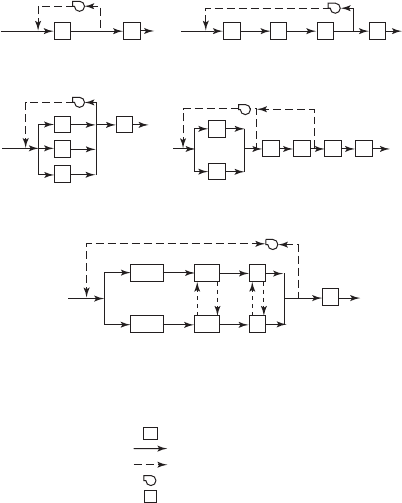
23-42 WATER AND WASTEWATER ENGINEERING
The GLUMRB (2004) loading recommendations are divided in two classes: controlled dis-
charge or, as it is more commonly called, seasonal discharge, and flow-through discharge. The
seasonal discharge ponds are those where the detention time and loading depend on climatic con-
ditions and
effluent discharge limits. The recommendations are:
• For controlled discharge: BOD
5
load ing range is 17 to 40 kg/ha · d at the mean operating
depth of the primary cell.
• For flow-through discharge: BOD
5
loading range is 17 to 40 kg/ha · d for the primary cell.
The primary cell is the first cell in a series arrangement of cells.
The U.S. EPA (1977) has proposed design criteria based on average winter air temperature
( Table 23-10 ).
Note that the GLUMRB guidance is much more conservative than the EPA guidance. GLUMRB
does not explain the rationale for the loading recommendations. EPA’s re
commendations are based
on field surveys.
Area. GLUMRB (2004) recommends that the maximum area of a pond cell be 16 ha. For
maximum flexibility the cells should be the same size.
Retention Time. The retention time is coupled with the surface loading rate as a controlling
design variable. Enough ti
me is required for the metabolic processes to proceed.
(a) Single
(c) Parallel (d) Parallel-Series
s
1
1
1
S
1
1
1
1
1
2
21 3 S
3 4S
(b) Series
2 3
2 3
S
(e) Parallel-Series
Legend
No. of unit in series
Possible recirculation
Recirculation pump
1,2,3,4
Normal flow
Solids removal unit
S
Cell in pond system
FIGURE 23-13
Facultative pond system configurations.
( Source: U.S. EPA, 1977.)

SECONDARY TREATMENT BY SUSPENDED GROWTH BIOLOGICAL PROCESSES 23-43
For the two classes, the GLUMRB (2004) recommendations are:
• For controlled discharge: at least 180 days detention time between the 0.6 m and maximum
operating depth of the pond.
• For flow-through discharge: a detention time of 90 to 120 days depending on the duration
of the cold period (temperature less than 5
C).
The U.S. EPA (1977) has proposed design criteria based on the average winter air tempera-
ture ( Table 23-11 ).
I n l o cations where ice forms, U.S. EPA (1977) recommends detention times of 150 to 240 days
or sufficient for the period of ice cover plus 60 days be provided. This is to prevent odor and to
polish the pond effluent.
A s shown in Fig
ure 23-14 , ponds located in warmer climates are typically designed for
higher surface loadings and shorter retention times.
Liquid Depth. U.S. EPA (1977) recommends the operating depths and extra depth for sludge
storage shown in Table 23-12 .
The minim um operating depth should not be less than 0.6 m to prevent growth of aquati
c
plants. The maximum water depth (not total depth) should be 1.8 m in primary cells (GLUMRB,
2004).
TABLE 23-11
U.S. EPA’s recommended facultative pond retention time
Average winter
air temperature, C
Primary cell
retention time,
d
Total system
retention time,
d
0C 30 to 80 80 to 180
0–15C15 to 30 40 to 60
15C 5 to 15 25 to 40
Source: U.S. EPA, 1977.
Average winter
air temperature, C
Primary cell
BOD loading rate,
kg/ha · d
Total system
BOD loading rate,
kg/ha · d
0C 34 to 67 11 to 22
0C–15C 67 to 135 22 to 45
15C135 to 202 45 to 90
TABLE 23-10
U.S. EPA’s recommended facultative pond loading rates
Source: U.S. EPA, 1977.
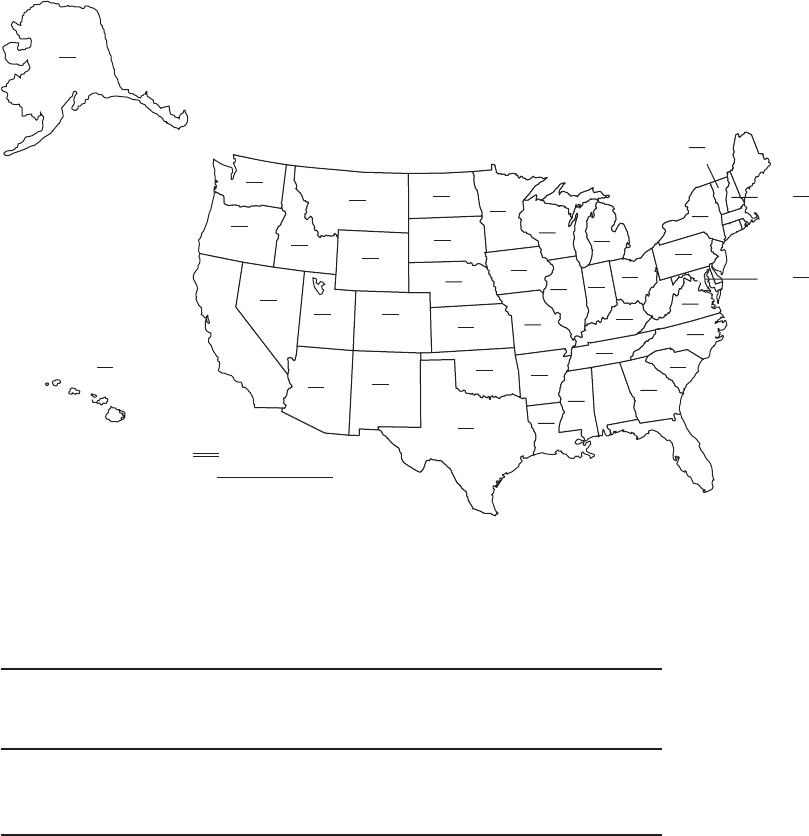
23-44 WATER AND WASTEWATER ENGINEERING
Average winter air
temperature, C
Primary cell
extra depth for
sludge storage, m
Total primary
cell depth,
m
Other cell
depths,
m
<0C 1.2 to 1.8 2.7 to 3.9 1.5 to 2.1
0C–15C 0.9 to 1.5 2.1 to 3.3 1.2 to 1.8
>15C 0.6 to 1.2 1.5 to 2.7 0.9 to 1.5
TABLE 23-12
U.S. EPA’s recommended facultative pond depths
Source: U.S. EPA, 1977.
FIGURE 23-14
Sample of state regulations on oxidation pond loading and retention time.
46
40
23
95
57
37
23
NS
23
150
23
150
25
100
40
NS
25
60
40
NS
46
NS
46
120
20
180
40
30
57
20
57
34
34
NS
34
NS
39
90
23
65
57
30
23
150
38
30
26
NS
25
65
38
NS
26
NS
40
NS
40
60
91
25
57
30
25
NS
5
7
NS
30
120
51
37
50
NS
57
NS
28
60
19
NS
NH
MD
23
160
VT
Pond loading in kg/ha.d
Retention time in days
1.
2.
NS = not specified
Key:
Inlet, Outlet, and Transfer Pipes. The inlet manhole should have an air break to prevent
siphoning of the pond contents into the sewer line. The invert should be at least 150 mm above
the maximum operating level of the pond ( Figure 23-15 ).
The inlet pipe has traditionally been placed near the center of the primary pond. This has lead
to problems with short circuiting. The recommended arrangement is to plac
e the discharge at the
one-third point between the inlet and outlet, that is, two-thirds the length away from the outlet.
The end of the discharge line should rest on a concrete apron large enough to prevent erosion. A
minimum size apron approximately 0.6 m square is recommended (GLUMRB, 2004).
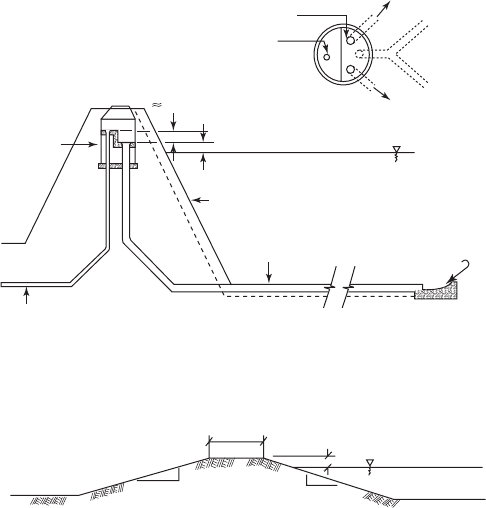
SECONDARY TREATMENT BY SUSPENDED GROWTH BIOLOGICAL PROCESSES 23-45
S ubmerged takeoffs are used to transfer wastewater from one cell to another and to discharge
the treated wastewater. A minimum of three pipes at different elevations is recommended. The
intakes must be located a minimum of 3.0 m away from the toe of the embankment and 0.6 m
from the top. A vertical withdrawal is used ( F
igure 23-16 ). An alternative is to provide a concrete
structure with sluice gates. Because the sluice gates will be mounted on the outlet of the structure,
they must be rated to hold the seal under the hydrostatic pressure from the lagoon.
To obtain maxim um removal of microbial cells by settling, the area near the outlet must be
designed to attain a surface overflow rate of less than about 32 m
3
/ m
2
· d and the velocities near
the outlet should be less than 0.02 to 0.025 m/s. U.S. EPA (1977) recommends construction of
baffles to obtain the desired quiescence. The presence of ice cover may preclude the use of this
feature.
Hydraulic Capacity. For controlled discharge systems, the hyd
raulic capacity must permit
transfer of water at a minimum rate of 150 mm of pond water depth per day at the available head.
For flow-through systems, the piping is designed to handle 250 percent of design maximum day
flow of the system.
FIGURE 23-15
Dimensions for lagoon structures.
Force main
Airbreak
Impervious barrier
(HDPE liner)
Lagoon bottom
Shallow saucer-
shaped pad
(a) Inlet structure for small lagoons (Not to Scale)
Minimum 1.2 m Dia
precast manhole
sections
To cell no.1
To cell no.2
To cell no.3
To cell no.4
Larger distance may be
needed to satisfy the hydraulic requirments
without surcharging the structure
Insert plug to
divert flow
Force main
(b) Lagoon dike
Max.water
elevation
3.6 m
Recommended
0.9 m Min
3 Max.
3 Max.
4 Min.
*
0.6 m min. depth
Max.water elevation
Min.slop not applicable
1
1
*Although 1:4 or flatter slopes, may be permitted
for large installations to dampen wave action, they
create more shallow water which will support
emergent vegetation that must be controlled.
300 mm
150 mm
NTS
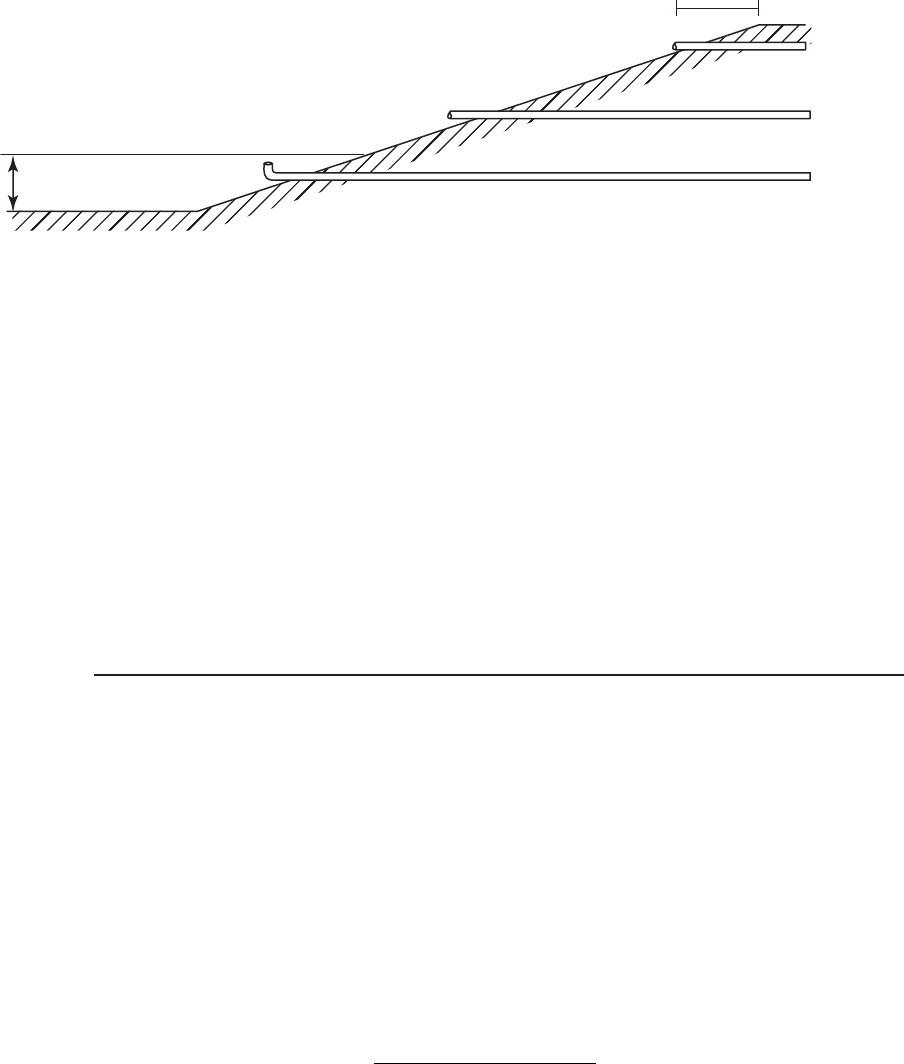
23-46 WATER AND WASTEWATER ENGINEERING
Pond Bottom Seal. The pond bottom must be sealed to prevent seepage loss. Clay liners and/or
impermeable material (for example, high density polyethylene, HDPE) have been used. A com-
mon standard for clay liners is a hydraulic conductivity of less than 1 10
7
cm/s. Michigan
requires a double liner, that is, HDPE plus clay.
Embankment. The minimum dike width should be 2.4 m to permit access for maintenance
vehicles. The recommended maximum inner and outer slope is 1:3 (vertical to horizontal) to
permit mowing. Inner slopes shoul
d not be flatter than 1:4 to prevent emergent vegetation. The
minimum freeboard should be 0.9 m. A typical profile is shown in Figure 23-15 .
Fencing. Because the ponds are an attractive nuisanc e and a safety hazard, a 2 m high chain-
link fence is typically placed at the outside toe of the embankment.
Example 23-7. Using the EPA criteria, design a
controlled discharge oxidation pond for
Waterloo. Waterloo is located in a state where the average winter temperature is 4
C. The design
assumptions are as follows:
Flow rate 2,000 m
3
/ d
BOD
5
200 mg/L
Three cells in series
Minimum operating depth 0.6 m
Solution:
a . Calculate the surface area of the total pond system assuming a conservative loading rate
of 22 kg/ha · d at 0C to 15
C from Table 23-10 . Note that 1.0 mg/L 1.0 g/m
3
. The
total lagoon surface area at the mean operating depth is
A
()( )
()(
200 2 000
1 000 22
33
g/mm/d
g/kg kg/
,
,
hha d
or ha
)
18 2 18.
Minimum
water elevation
0.6 m
Transfer pipe
Transfer pipe
Transfer pipe
0.6 m
FIGURE 23-16
Dimensions for transfer pipes. Note lowest pipe has upturned intake.

SECONDARY TREATMENT BY SUSPENDED GROWTH BIOLOGICAL PROCESSES 23-47
b. For three cells of equal size, the loading rate for the primary cell is
LR
()( )
()()
200 2 000
1 000 6
33
g/mm/d
gkg ha
,
, /
66 67 67. or kg/ha d
This is within the EPA recommended loading of 67 to 135 kg/ha · d for primary cells.
However, the loading is larger than the more conservative GLUMRB recommendation
of 17 to 40 kg/ha · d.
c. Select a conservative total retention time of 60 d at 0C to 15
C from Table 23-11 . For
three cells with the same volume, the retention time in the first cell is
60
3
20
d
cells
d/cell
This is within the acceptable range for the primary cell.
d. The mean operating depth of the three-cell system is the average operating depth plus the
minimum operating depth.
Average depth
m /dd
ha
()()
()(
2 000 60
18 10
3
,
,
0000
067
2
m /ha
m
)
.
With a minimum operating depth of 0.6 m, the mean operating depth from the bottom of
the cell is
Mean operating depth mm m067 06 127...
e. The pond system will then operate between the minimum operating depth and twice the
average depth. Thus, the maximum operating depth is
Maximum operating depth mm2067 06 19()...4419or m.
This is slightly over the maximum recommended level of 1.8 m.
f. The total depth of a cell is then
Total depth mmfreeboardm 19 09 28.. .
g. Assum ing a square pond, the dimensions at the mean operating depth for each of the
three ponds are
[( )( )]6 10 000 244 95 245
212
ha m /ha or m o
/
,. nneach side
Post-Pond Treatment. Three treatment processes may be required after s tabilization in the
oxidation pond. These are disinfection, removal of suspended solids, and/or post-aeration. Disin-
fection and post-aeration are discussed in Chapter 25. Suspended solids removal is discussed in
the following paragraphs.
